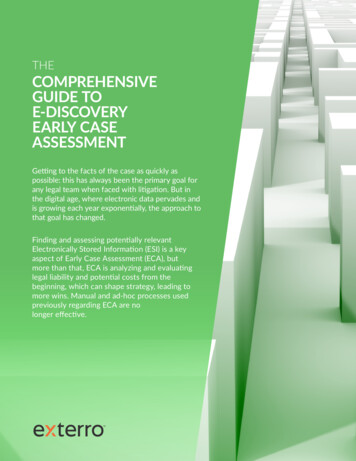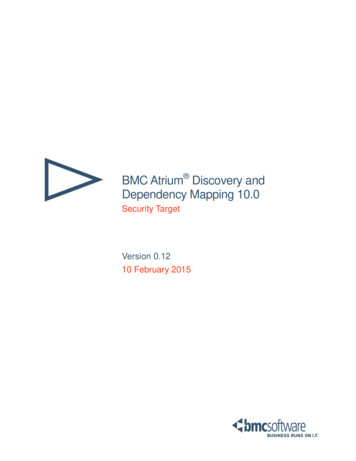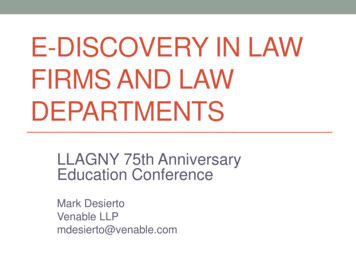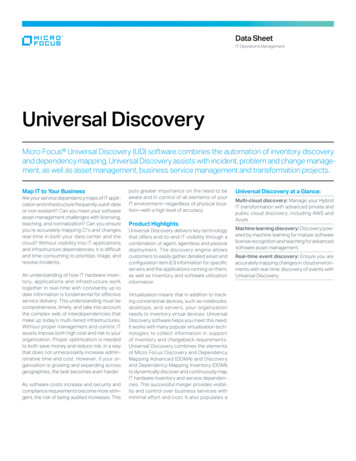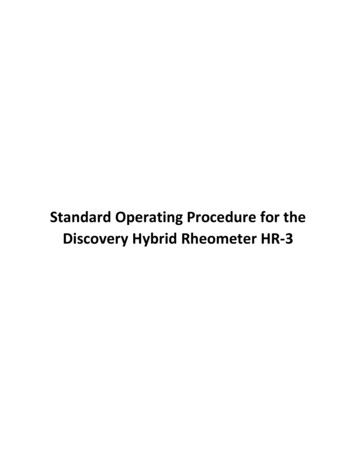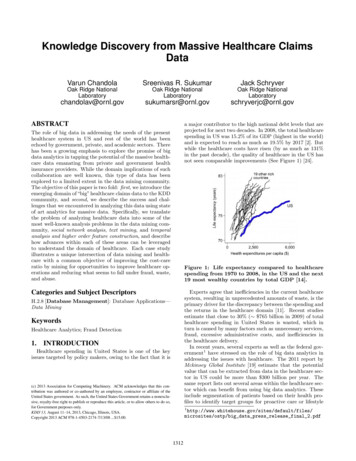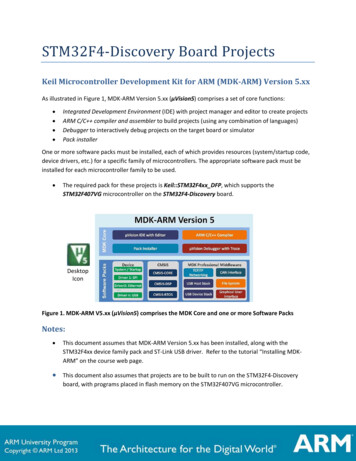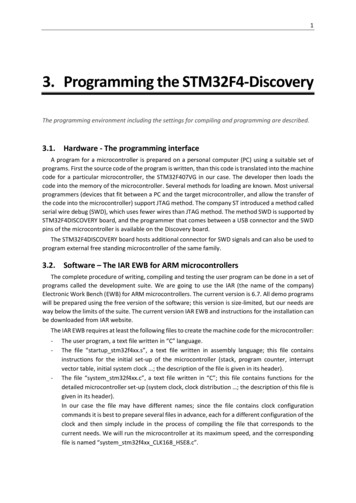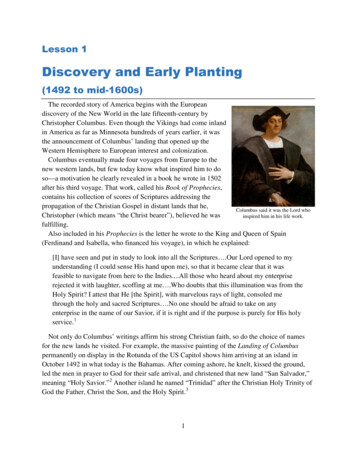
Transcription
Lesson 1Discovery and Early Planting(1492 to mid-1600s)The recorded story of America begins with the Europeandiscovery of the New World in the late fifteenth-century byChristopher Columbus. Even though the Vikings had come inlandin America as far as Minnesota hundreds of years earlier, it wasthe announcement of Columbus’ landing that opened up theWestern Hemisphere to European interest and colonization.Columbus eventually made four voyages from Europe to thenew western lands, but few today know what inspired him to doso—a motivation he clearly revealed in a book he wrote in 1502after his third voyage. That work, called his Book of Prophecies,contains his collection of scores of Scriptures addressing thepropagation of the Christian Gospel in distant lands that he,Columbus said it was the Lord whoChristopher (which means “the Christ bearer”), believed he wasinspired him in his life work.fulfilling.Also included in his Prophecies is the letter he wrote to the King and Queen of Spain(Ferdinand and Isabella, who financed his voyage), in which he explained:[I] have seen and put in study to look into all the Scriptures .Our Lord opened to myunderstanding (I could sense His hand upon me), so that it became clear that it wasfeasible to navigate from here to the Indies.All those who heard about my enterpriserejected it with laughter, scoffing at me .Who doubts that this illumination was from theHoly Spirit? I attest that He [the Spirit], with marvelous rays of light, consoled methrough the holy and sacred Scriptures .No one should be afraid to take on anyenterprise in the name of our Savior, if it is right and if the purpose is purely for His holyservice.1Not only do Columbus’ writings affirm his strong Christian faith, so do the choice of namesfor the new lands he visited. For example, the massive painting of the Landing of Columbuspermanently on display in the Rotunda of the US Capitol shows him arriving at an island inOctober 1492 in what today is the Bahamas. After coming ashore, he knelt, kissed the ground,led the men in prayer to God for their safe arrival, and christened that new land “San Salvador,”meaning “Holy Savior.”2 Another island he named “Trinidad” after the Christian Holy Trinity ofGod the Father, Christ the Son, and the Holy Spirit.31
For almost five centuries, Columbuswas celebrated as a hero, with over 600monuments being erected to honor him.4In fact, the city of Washington, DC wasnamed after him (DC stands for Districtof Columbia, or Columbus).5 But inrecent years, he has been portrayed as avillain because of his so-called atrocious“treatment” of Native Indians. But sadly,too many of today’s narratives fail to giveArchitect of the Capitolthe true factual story of his encountersLanding of Columbus displayed in the US Capitoland relationships with those peoples.Columbus was involved with two principal Indian tribes. The first, the Taíno, was a very kindand gentle people, and Columbus repeatedly praised them as “the best people in the world.”6 Hewrote Spain, advocating for their full equality, citizenship, and civil rights. The second tribe, theCaribs, was the mortal enemy of the Taíno, raiding their villages, enslaving their people, andespecially cannibalizing them. When Columbus arrived on his first journey, the Taíno told himabout these atrocities, so on his second voyage Columbus journeyed to the Carib lands to see ifthe reports were true.7Arriving there, he discovered slave camps where the Caribs housed Taino captive women whowere raped for the purpose of producing children for the Caribs to eat. The stories of the barbariccannibalism were confirmed by the abundance of human remains found boiling in the cookingpots as well as the gnawed bones throughout the camps.8 Columbus liberated the enslavedwomen and proceeded to fight against the Caribs whenever they engaged him (and the Caribshad attacked and murdered dozens of his men).9So Columbus was largely just and kind with the Taíno tribes but did indeed war against thehorrific cannibal Caribs. Yet claims abound today that Columbus sought to destroy and pillageall Indians, without discussing who he fought or even why he was fighting them. Modern criticsalso fail to mention the good relations he had with many tribes.Another modern claim is that Columbusenslaved Natives and forcibly carried them backwith him. But nearly all those he forciblybrought to Spain were cannibalistic Caribmurderers, captured in open war. Some of thefriendly Indians had volunteered to travel backto Spain with Columbus, including an importantlocal chieftain and his entire family, butColumbus urged him to stay in his ownkingdom.10 One Indian who chose to go withColumbus after his first voyage actually becameColumbus' Return to Spain2
a member of the royal Spanish court; another took Columbus’ last name and traveled with him ashis interpreter for his various visits to native tribes. 11But returning to Columbus’ “discovery” of the New World, it is significant that whileColumbus is credited with opening the western hemisphere to European colonization, neither henor Spain (the nation for which he sailed) actually colonized what would eventually become theUnited States. This is fortunate, for at that time, civil and religious tyranny were common inSpain and numerous other nations of Europe.This Spanish tyranny was not Columbus’ practice, however, for he was Italian, not Spanish.He sailed under the banner of Spain simply because they funded his voyages, not because heagreed with their people or practices. In fact, on numerous occasions, he openly denounced theatrocious behavior of many of the Spaniards who had been assigned to him as his crew.12Fortunately, it was nearly a century after Columbus’ discovery of the new western landsbefore permanent colonists began arriving in America. Why the long wait? Nineteenth centuryhistorian B.F. Morris explained:[G]od held this vast land [America] in reserve as the great field on which the experimentwas to be made in favor of civil and religious liberty. He suffered not the foot of aSpaniard, or Portuguese, or Frenchman, or Englishman to come upon it until the changeshad been wrought in Europe which would make it certain that it [America] would alwaysbe a land of [Biblical] freedom.13Those “changes wrought in Europe” refer to what today is called the Reformation—a religiousmovement that birthed both civil and religious liberty in several nations. That movement beganin the 1300s and for the next two centuries steadily spread across Europe and then into otherparts of the world.The movement began with several Catholic priests urging a return to the teachings of theBible—teachings that had been largely ignored by both State and Church over the previousthousand years. This back-to-the-Bible movement (that is, the Reformation) began a reform ofthe Catholic Church and also birthed the Protestant Church.One particularly strong emphasis of that movement was to make the Bible available to theaverage person in his own language. Over previous centuries, the Bible had been largelyunavailable to the ordinary individual and was nearly always written in a foreign language thatonly a handful of the elite and most highly-educated could read. But with the Reformation,Bibles became available for all citizens in their own language; and when the people began toread and apply the Bible and its teachings, their personal lives and practices changed. This had adirect beneficial impact on both State and Church, for as Biblical principles of liberty becameknown and adopted, both civil and religious tyranny began decreasing.With the gradual return to Biblical teachings, key theological ideas were recovered by theChurch, including Sola Scriptura (“by Scripture alone”), Sola Fide (“by faith alone”), SolaGratia (“by grace alone”), Solus Christus or Solo Christo (“Christ alone” or “through Christ3
alone”), and Soli Deo gloria (“glory to God alone”). Many new Christian denominations werebuilt upon these ideas, and they impacted the society at large in a positive manner.America, perhaps more than any other country at the time, was directly shaped by theReformation, for the early colonists who settled here (including the Pilgrims, Puritans, andothers) were a direct product of Reformation teachings. In fact, many of them had been drivenfrom Europe simply because they sought to live out their faith according to Bible precepts, andin America they found the freedom to openly live their lives by its teachings on government,economics, law, family, education, and much else.As a result, the Biblical concepts of religious freedom, representative government, individualenterprise, jurisdictional authority, limited government, and private property began to appear inmany of the civil documents that came forth in the seventeenth and eighteenth centuries (such asthe Mayflower Compact, the Fundamental Orders of Connecticut, the Massachusetts Body ofLiberties, the Frame of Government of Pennsylvania, the Declaration of Independence, and theUnited States Constitution). Personal liberty as well as religious, civil, political, and economicliberty was the result of applying the Bible’s teachings to all areas of life.In fact, the Bible became so influential in the birth, growth, and development of the UnitedStates that even modern publications such as Newsweek affirm that “historians are discoveringthat the Bible, perhaps even more than the Constitution, is our founding document.”14 WithoutGod and the Bible, there would be no free and prosperous America as we have come to know ittoday.The Bible: The Rock of Our RepublicInterestingly, one group of American leaders that repeatedly affirmed the historic impact ofBible teachings in shaping America was US Presidents. For example:In the formative days of the Republic, the directing influencethe Bible exercised upon the fathers of the Nation isconspicuously evident .We cannot read the history of ourrise and development as a Nation without reckoning with theplace the Bible has occupied in shaping the advances of theRepublic.15 I suggest a nationwide reading of the HolyScriptures .for a renewed and strengthening contact withthose eternal truths and majestic principles which haveinspired such measure of true greatness as this Nation hasachieved.16 PRESIDENT FRANKLIN DELANO ROOSEVELTFranklin Delano Roosevelt[T]he teachings of the Bible are so interwoven and entwined with our whole civic andsocial life that it would be literally—I do not mean figuratively, I mean literally—impossible for us to figure to ourselves what that life would be if these teachings wereremoved. We would lose almost all the standards by which we now judge both public andprivate morals—all the standards toward which we, with more or less resolution, strive toraise ourselves. Almost every man who has by his life-work added to the sum of human4
achievement of which the [human] race is proud—of which our people are proud—almost every such man has based his life-work largely upon the teachings of the Bible.17PRESIDENT TEDDY ROOSEVELTRonald ReaganOf the many influences that have shaped the United States of Americainto a distinctive Nation and people, none may be said to be morefundamental and enduring than the Bible .The Bible and itsteachings helped form the basis for the Founding Fathers’ abidingbelief in the inalienable rights of the individual—rights which theyfound implicit in the Bible’s teachings of the inherent worth anddignity of each individual.18 PRESIDENT RONALD REAGANIt was for the love of the truths of this great Book [the Bible] that our fathers abandonedtheir native shores for the wilderness. Animated by its lofty principles, they toiled andsuffered till the desert blossomed as the rose [Isaiah 35:1].19 The Bible is the best ofbooks and I wish it were in the hands of everyone. It is indispensable to the safety andpermanence of our institutions; a free government cannot exist without religion andmorals, and there cannot be morals without religion, nor religion without the Bible.Especially should the Bible be placed in the hands of the young. It is the best school bookin the world .I would that all of our people were brought up under the influence of thatHoly Book.20 PRESIDENT ZACHARY TAYLORHold fast to the Bible as the sheet-anchor of your liberties. Write itsprecepts in your hearts, and practice them in your lives. To the influence ofthis book we are indebted for all the progress made in true civilization, andto this we must look as our guide in the future.21 PRESIDENT U.S. GRANTUlysses S. Grant[The Bible] is the best gift God has given to men. All the good the Saviorgave to the world was communicated through this book. But for it, we could not knowright from wrong.22 PRESIDENT ABRAHAM LINCOLNAmerica was born to exemplify that devotion to the elements of righteousness which arederived from the revelations of Holy Scripture.23 PRESIDENT WOODROW WILSONThe fundamental basis of this Nation’s law was given to Moses on theMount. The fundamental basis of our Bill of Rights comes from theteachings which we get from Exodus and St. Matthew, from Isaiah andSt. Paul. I don’t think we emphasize that enough these days.24 PRESIDENTHARRY TRUMANHarry TrumanBut long before our Presidents stressed the importance of the Bible, our Founding Fathers(the early leaders largely responsible for the birth and establishment of America as anindependent nation) had already done so. For example:5
[T]he Bible is the best book in the world.25 Suppose a nation in somedistant region should take the Bible for their only law book and everymember should regulate his conduct by the precepts there exhibited .What a Utopia—what a Paradise would this region be!26 JOHN ADAMS,SIGNER OF THE DECLARATION OF INDEPENDENCE, PRESIDENTJohn Adams[T]he Bible contains more knowledge necessary to man in his present state than any otherbook in the world.27 By renouncing the Bible, philosophers swing from their mooringsupon all moral subjects .It is the only correct map of the human heart that ever has beenpublished.28 BENJAMIN RUSH, SIGNER OF THE DECLARATION OF INDEPENDENCE[The Bible] is a book worth more than all the other books that were ever printed.29PATRICK HENRYJohn Quincy Adams[N]o book in the world deserves to be so unceasingly studied and soprofoundly meditated upon as the Bible.30 The first and almost the onlybook deserving such universal recommendation is the Bible.31 JOHNQUINCY ADAMS, PRESIDENT[W]ere you to ask me to recommend the most valuable book in the world, I should fix onthe Bible as the most instructive both to the wise and ignorant. Were you to ask me for onebook affording the most rational and pleasing entertainment to the enquiring mind, Ishould repeat, it is the Bible. And should you renew the inquiry for the best philosophy,or the most interesting history, I should still urge you to look into your Bible. I wouldmake it, in short, the alpha and omega of knowledge.32 ELIAS BOUDINOT, PRESIDENT OFTHE CONTINENTAL CONGRESS, FRAMER OF THE BILL OF RIGHTSThe Bible is the best of all books, for it is the Word of God and teachesus the way to be happy in this world and in the next. Continue thereforeto read it and to regulate your life by its precepts.33 JOHN JAY,PRESIDENT OF THE CONTINENTAL CONGRESS, AUTHOR OF THE FEDERALISTPAPERS, ORIGINAL CHIEF JUSTICE OF THE US SUPREME COURTJohn JayI believe the Bible to be the written Word of God and to contain in it the whole rule offaith and manners.34 ROBERT TREAT PAINE, SIGNER OF THE DECLARATION OFINDEPENDENCE[T]he Holy Scriptures .can alone secure to society order and peace, and to our courts ofjustice and constitutions of government, purity, stability, and usefulness .Bibles arestrong entrenchments [lines of defense]. Where they abound, men cannot pursue wickedcourses and at the same time enjoy quiet conscience.35 JAMES MCHENRY, SIGNER OF THECONSTITUTION6
All of the miseries and evils which men suffer from vice, crime, ambition, injustice,oppression, slavery and war, proceed from them despising or neglecting the preceptscontained in the Bible.36 NOAH WEBSTER, EARLY EDUCATOR, “SCHOOLMASTER TOAMERICA”There are similar declarations from countless other noted national leaders.The Virginia ColonyMany of the early explorers who had been influential in the growth and development ofAmerica were inspired by a love of God and His word. One such example was Richard Hakluyt(1558-1603), a Gospel minister and the greatest English geographer of America’s earlycolonization period. For decades he advocated for America to become a safe haven for thosebeing persecuted for their desire to live by God’s Word. As he explained in his 1584 Discourseon Western Planting:We shall, by planting there [in America], enlarge the glory of the Gospel, and fromEngland plant sincere religion and provide a safe and a sure place to receive people fromall parts of the world that are forced to flee for the truth of God’s Word.37The Rev. Hakluyt was a member of the governing body of Virginia–America’s first successfulcolony. And not surprisingly, the original charter of Virginia (1606) openly declared its Christianbeliefs, affirming that the colony was being started to propagate the “Christian religion to suchpeople as yet live in darkness and [unhappy] ignorance of the true knowledge and worship ofGod.”38Jamestown, 1607The first Virginia settlers landed in America in April 1607. They erected a wooden cross atCape Henry, where they came ashore. At the foot of this cross, the Rev. Hunt led the 149 men ofthe Virginia Company in prayer, thanking God for their safe journey and recommitting the groupto God’s plan and purpose for the New World.John Smith and PocahontasThose settlers sailed up a nearby river and chose a site for their new colony. They named thewaterway up which they journeyed the “James River,” and their new settlement “Jamestown”—both in honor of King James of England.The initial reaction of the neighboring Indians to this unexpected but friendly arrival was fear,suspicion, and outright hostility. In fact, only two weeks after their arrival, 200 Indians made asurprise attack on the settlement, killing two and wounding ten others. But this hostile beginningeventually changed, thanks in large part to Pocahontas, the young daughter of Powhatan, chief ofthe neighboring Indians.Pocahontas befriended the colonists from the beginning, causing John Smith (who would laterbecome governor of the Virginia Colony) to state that it was the “ordinance of God thus to makeher His instrument.”39 According to Smith, she was “next, under God, the instrument to7
preserve this colony from death, famine, and utter confusion.”40 His initial meeting withPocahontas, however, was certainly unplanned.Smith and a small group were exploring the region around theirsettlement when they were captured by a band of Indians and taken toPowhatan’s village. Those with him were tortured and killed, andSmith was held captive for weeks. Eventually, the Indians orderedhim killed as well. They placed his head on a large stone, preparing,as Smith himself reported, “with their clubs, to beat out his brains.”41At that moment, Pocahontas intervened. She took Smith’s “head inher arms and laid her own [head] upon his to save him fromdeath.”42 She pleaded for his life, which her father granted.Carved relief in the US CapitolRotunda showing PocahontasPowhatan declared they were now friends and that Smith could gosaving John Smith’s life.back to Jamestown. Smith did so, but fearfully, “still expecting, as [I]had done all this long time of [my] imprisonment, every hour to be put to one death orother.But Almighty God, by His Divine Providence, had mollified [softened] the hearts of thosestern barbarians with compassion.”43 Pocahontas saved Smith from death, and over the comingmonths she also saved many others of the Jamestown settlers as well.For example, during theirfirst winter, their food ran out;but Pocahontas wasinstrumental in getting Indiansto bring them supplies. Shebrought food to the starvingcolonists at other times as well,and also helped them securepeace treaties with surroundingtribes. Early historian JohnFiske writes of Pocahontas:“But for her friendly serviceson more than one occasion, theArchitect of the Capitoltiny settlement would probablyThe painting of the Baptism of Pocahontas in the US Capitol Rotundahave perished.”44The colony survived and slowly began to grow, openly espousing Christian principles. Forexample, between 1609 and 1612, their code of civil laws (called their Lawes Divine, Morall,and Martiall, etc.) was penned, and it succinctly affirmed the intent of the colonists to liveaccording to God’s commands.45In 1619, civic elections were held in Jamestown, and the result was the first electedrepresentative body of the New World. It opened with prayer, and then met in the choir loft ofthe church.46 One of the early acts of this body was to encourage colonists to open their homes toIndian youth with the purpose of teaching them the precepts of the Bible.478
Significantly, many Native Americans became Christians, including Pocahontas, who wasbrought to a knowledge of Jesus Christ by the ministry of the Rev. Alexander Whitaker andothers. In fact, a massive painting hanging in the US Capitol Rotunda (near that of Columbus’landing) shows the baptism of Pocahontas by the Rev. Whitaker. After her baptism, Pocahontasadopted the Christian name Rebecca, by which she was called the remainder of her life.Governor John Smith, like somany others in the Virginia Colony(including Rebecca) was anoutspoken Christian. His personalfaith was reflected in many openacknowledgments of God throughouthis life, including his Last Will andTestament (1631):[I] commend my soul into thehands of Almighty God, myMaker, hoping through the meritof Christ Jesus my Redeemer toreceive full remission of all mysins and to inherit a place in theeverlasting kingdom.48Architect of the CapitolThe painting of the Embarkation of the Pilgrims shows them onthe ship the Speedwell observing a time of fasting and prayerbefore leaving Holland to come to America.The Pilgrims and the Plymouth Colony, 1620Another of the massive paintings that hangs in the US Capitol Rotunda (each is 14 feet highand twenty feet wide) is the Embarkation of the Pilgrims at Delfts Haven, Holland, July 22nd,1620, painted by Robert Weir and placed in the Capitol in 1843.49This painting shows leading Pilgrims in prayer (including PastorJohn Robinson, Governors John Carver and William Bradford,military leader Miles Standish, and others). In the center of thepainting, Elder William Brewster has an open Bible upon his lapon which are written the words: “The New Testament of our Lordand Savior Jesus Christ.” On the sail of the ship can be seen thephrase, “God with Us,” which accurately describes the lifestyle ofthese men and women.Architect of the CapitolThe version of the Bible being held by Brewster (and the versionPainted on the sail is the phrase,“God with us,” which was the heartused extensively by the Pilgrims) was known as the Geneva Bible.cry of the Pilgrims.It was the primary Bible of the English Reformation and was thefavorite Bible of the Dissenters—those who largely settled America. (They were calledDissenters because they objected to—that is, dissented from—the corrupt European practices ofboth State and Church).9
The Geneva Bible was first published in Geneva,Switzerland, in 1560 by English reformers (and theirfollowers) who had fled there to escape severe religiouspersecution at the hands of the state-establishedchurches in their various home countries. That Biblewent through 140 editions from 1560 to 1644.50 It wasthe first Bible to add numbered verses to each chapter.Architect of the CapitolWilliam Brewster is holding an open GenevaIt was also the first Bible to be taken to America,Bible with the words, “The New Testamenthaving been carried first by the Virginia colonists andof our Lord and Savior Jesus Christ.”then by the Pilgrims.One factor that made the Geneva Bible distinctive from all other Bibles at the time was itsunique marginal commentaries. Penned by prominent reformers, these commentaries regularlychallenged the corrupt European culture of the day, especially criticizing practices that violatedGod’s Word, whether in government, judiciary, education, law, culture, or elsewhere.The Dissenters, by their study of the Geneva Bible and its commentaries, saw how flawed thecivil and religious system was at that time in most countries across Europe. When the Dissentersin England publicly pointed this out, they received vigorous persecution from the stateestablished national church. (This same pattern of ill-treatment by state-established churches wascommon across Europe.)After years of enduring this government persecution, the Pilgrims (according to their governorand historian, William Bradford) finally “shook off this yoke of anti-Christian bondage, and asthe Lord’s free people joined themselves (by a covenant of the Lord) into a church estate, in thefellowship of the Gospel, to walk in all His ways.”51 They left England and went to Holland,where they finally found religious freedom.But after twelve years in the secular culture of Holland, they became concerned for the faith oftheir children. They also preferred the overall English culture to that of the Dutch, so theydecided to move to the new land of America, where they could (1) freely worship God, (2) raiseGodly children, and (3) share the wonderful truths of the Christian Gospel with others.Concerning this third point, Bradford affirmed that the Pilgrims had: “a great hope and inwardzeal for the propagating and advancing the Gospel of the kingdom of Christ in those remoteparts of the world [i.e., America].”52When they set sail for America in 1620 aboard the ship Mayflower, it bore 102 “Pilgrims andstrangers” (which they called themselves—a quote from 1 Peter 2:11 in the Bible). But the shipalso carried much more: it carried the Bible-based principles they had learned—principles thatwere to become the seeds of the greatest and freest nation the world has ever known.After sixty-six days at sea, including sailing through some treacherous storms, the Mayflowerfinally reached America. The Pilgrims had intended to settle in the northern parts of the existingVirginia Colony and had tried diligently to reach that region, but despite their best efforts, fiercewinds providentially blew them far north to a region completely outside Virginia’s jurisdiction.10
They finally put ashore at Cape Cod in the Massachusetts area, and after some searching theyfound an empty and uninhabited location in which to settle.Significantly, had the Pilgrims arrived at that same place some years earlier, they would havebeen met by the fierce Patuxet Indian tribe, which likely would have attacked and killed them all.But in 1617, a plague had mysteriously wiped out all of the tribe except one man: Squanto. Hehad been in England at the time of the outbreak and returned to the area just before the Pilgrimsarrived, finding his entire tribe gone. Due to the devastating nature of the epidemic, theneighboring tribes were afraid to come near the place; they believed that some great supernaturalspirit had destroyed the people there and might also kill them as well. So the land was leftabandoned and open—a perfect situation for the Pilgrims.Having arrived in an area not under the authority of the Virginia Colony, the Pilgrims drew uptheir own governmental compact before leaving the Mayflower, which declared:Having undertaken for the glory of God and advancement of the Christian faith, and thehonor of our king and country, a voyage to plant the first colony in the northern parts ofVirginia, do by these presents [that is, by this legal document and charter] solemnly andmutually, in the presence of God and one of another, covenant and combine ourselvestogether into a civil body politic.53That document, known as the Mayflower Compact, was the first civil governing documentwritten in America and the NewWorld. It placed the Pilgrim’s civilgovernment on a firm Christian basisand was the beginning of Americanconstitutional government.When the Pilgrims came ashore,they fell to their knees and thankedGod, reaffirming their continuingreliance upon Him. Squanto later metthem and would become instrumentalin their survival. (For more on thispart of the story, see the article in theAppendix at the end of Lesson 1,Signing of the Mayflower Compact“Why We Celebrate Thanksgiving”).The Pilgrims’ Colony became known as Plymouth Plantation, or the Plymouth Colony. It wasbuilt on land purchased from the Indians—at the price set by the Indians.54 In fact, the longestlasting treaty in American history between Anglos and Native Americans was that of thePilgrims. (For more on the relations between the Pilgrims and Indians, see “No, Revisionists,Thanksgiving is not a Day of Mourning,” also at the end of this Lesson).In the beginning, life in that colony was very difficult. In fact, in the first winter alone, half thePilgrims died. But despite that hardship, the next spring when the Mayflower returned to11
England, not one Pilgrim chose to go back. They all stayed, for they had come neither forpersonal convenience nor reward but rather that they might walk in religious and civil liberty andbecame what they called “stepping stones”55 for others after them to follow and do the same. Atthe end of the first year, the Pilgrims celebrated the thanksgiving festival that has become thenational holiday we still celebrate each year today in November.The Laws of the PilgrimsThe Pilgrims believed the Bible was a complete guidebook for how to live all of life, and theircode of laws clearly reflected this belief. Significantly, much of what they instituted (as early as1623) became standard in America, including trial by jury and private property rights.56 Theyalso elected the
Bible—teachings that had been largely ignored by both State and Church over the previous thousand years. This back-to-the-Bible movement (that is, the Reformation) began a reform of the Catholic Church and also birthed the Protestant Church. One particularly strong emphasis of that movemen
